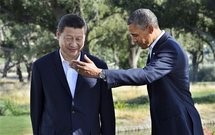 With President Barack Obama cancelling his recent four-nation Asian tour owing to the political standoff over the US budget that led to a shutdown of non-essential government services, comments and doubts about America becoming a nation that is politically dysfunctional and on the verge of another economic crisis loom large world over. In this backdrop, Washington's commitment to its strategic "pivot" to Asia too has come under the scanner once again. The pivot has often been interpreted as a revival of the military and economic influence of the United Sates in Asia--more so, to balance out a rising and increasingly assertive China.
With President Barack Obama cancelling his recent four-nation Asian tour owing to the political standoff over the US budget that led to a shutdown of non-essential government services, comments and doubts about America becoming a nation that is politically dysfunctional and on the verge of another economic crisis loom large world over. In this backdrop, Washington's commitment to its strategic "pivot" to Asia too has come under the scanner once again. The pivot has often been interpreted as a revival of the military and economic influence of the United Sates in Asia--more so, to balance out a rising and increasingly assertive China.
President Obama was scheduled to visit Malaysia and the Philippines followed by participating in regional summits including the Asia-Pacific Economic Cooperation (APEC) summit in Bali and the East Asia Summit, organised by the Association of Southeast Asian Nations (ASEAN) in Brunei. Could the no-show by the American President work in favour of a cash-rich China given that President Obama was scheduled to meet Chinese President Xi Jinping at the summits? Has a distracted Washington further accentuated perceptions that China has, in some ways, outflanked the US pivot at least for the time being?
Incidentally, it was at these very APEC and East Asia Summits earlier that President Obama announced the US’ strategic pivot, or rebalancing, towards Asia. Washington has often chosen to demonstrate America’s commitment to the Asia-Pacific region especially to the ASEAN-led regional security architecture—a central plank of the Obama administration's Asia policy.
While Obama chose to tackle the situation back home, Mark A Welsh, Chief of Staff of the United States Air Force met with his Chinese counterpart, Ma Xiaotian, also a member of the Central Military Commission (CMC) and commander of PLA Air Force (PLAAF) in September at the PLAAF Headquarters. It was agreed that cordial relations between the respective air forces were indeed an important component of the military diplomacy of the American and Chinese militaries. Ma Xiaotian expressed China’s willingness to make joint efforts with Mark Welsh to push forward exchanges and cooperation between the two air forces to build a mutually beneficial air and space environment. The US Air Force in particular is keen to expand bilateral exchanges in the professional and technical fields.
Obama cancelling his visits to Indonesia and Malaysia on the one hand and Xi Jinping announcing a raft of deals worth $ 30 billion in Indonesia followed by the announcement of a "comprehensive strategic partnership" with Malaysia including upgrading military ties, appear symptomatic of the portentous concerns within Asia over the actual sustainability of the American commitment to the region. It takes one back to statements such as the one made by former Secretary of State Hillary Clinton when she declared two years ago "… we are back to stay” as a power in Asia. American diplomacy has surely taken a hit vis-à-vis supporting its allies that are concerned and at the receiving end of China's assertive maritime expansion especially in the East China Sea and South China Sea.
Chinese companies invested $4.42 billion in Southeast Asia in 2012, up 52 percent from the previous year. Securing its position since 2011 as the largest trading partner with most Asian countries, China has managed to attract smaller countries such as Laos and Cambodia into its economic orbit with Vientiane and Phnom Penh being termed as Beijing’s "client states" which support the Chinese position on various outstanding regional disputes. According to the China-ASEAN Business Council, Beijing is the biggest trade partner of ASEAN since 2009, with surging direct investments.
China's diplomacy with Southeast Asia runs rapidly in contrast with growing Chinese naval operations from its new naval base in the south of the Hainan Island. The rise of China economically and its consequent policy of engaging the region, by no means can take the light away from the military-security dimension given the apprehensions of the ASEAN states vis-à-vis China’s quest to seek regional hegemony. China’s tendency to negotiate individually with weaker Southeast Asian states has not gone unnoticed in the region although Beijing reaffirms that it “would commit itself to becoming a force for peace and stability in Southeast Asia.”
By Special Arrangement with The Centre For Land Warfare Studies (CLAWS) (http://www.claws.in)